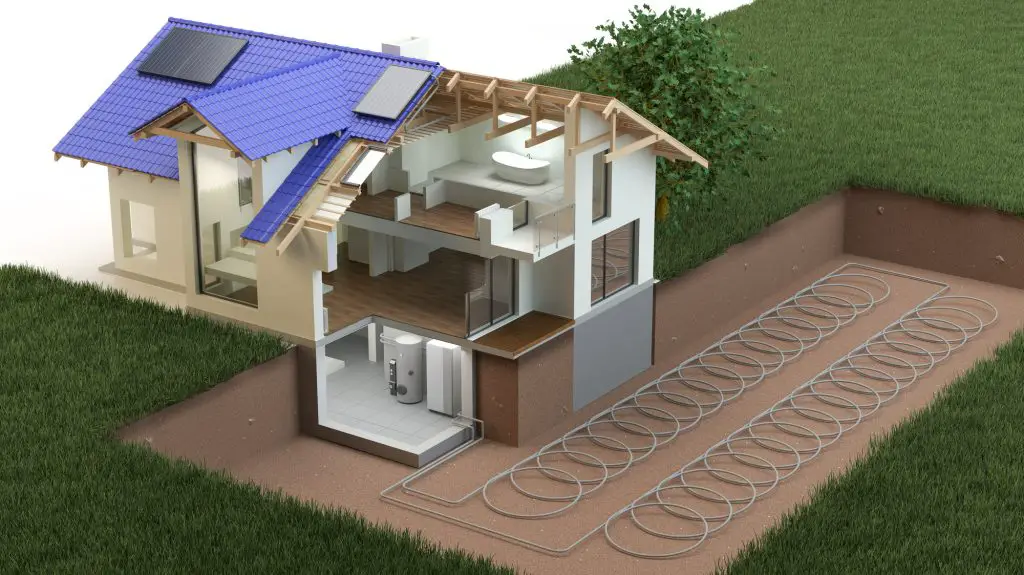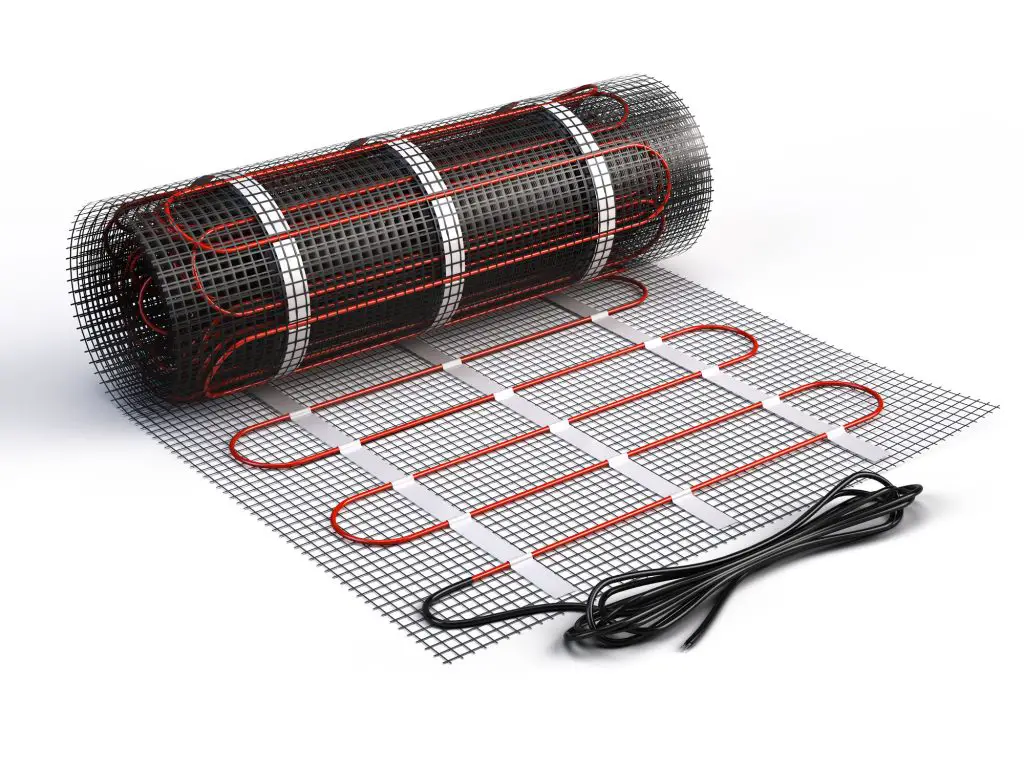Combining a ground source heat pump with an underfloor heating system is a really attractive prospect. The heat from the ground beneath your garden or outside space can warm the floors of your home for years and years. We will examine the key considerations, costs and challenges faced when combining underfloor heating with a ground source heat pump.
Ground source heat pumps combine well with underfloor heating systems. Both technologies feature the flow of fluid through pipes, with heat being exchanged from the ground and later through your floor. Installations can be expensive and disruptive and adequate outdoor space is essential.

How do ground source heat pumps work, and how do they connect to underfloor heating systems?
A ground source heat pump uses thermal energy captured from the ground, which is then used to heat a building. In order to transfer heat from the ground beneath your garden, underground pipes are laid out in either a horizontal array or inside a deep vertical borehole.
Due to the relatively constant temperatures below the surface, a ground source heat pump system can be used all year round. An underground pipe network, also known as a ground array or ground loop, is laid approximately 1.2 meters under the surface (in a horizontal array) and is filled with a mix of antifreeze and water.
Solar energy is absorbed and stored in the ground all year round, the pipes laid beneath the soil absorb this heat and the fluid running through them warms up. The fluid runs through the pipe system and back to a control hub inside the home. The control hub then uses expression and contraction technology to efficiently extract this heat from the pipe fluid, which then continues to circulate around the array.
A buffer tank is used between a ground source heat pump and underground floor heating. The pressure from GSHP is reduced at the buffer tank, which then supplies hot water to underfloor heating. The pressure in a geothermal heat pump is around 50 psi. In contrast, it is just 1 to 2 psi in pipes of water-based underfloor heating.

Ground-source heat pumps generate heat based on the length of the ground loop. If your house is bigger, you’ll need a longer ground loop.
In addition to providing a buffer of stored hot water for the underfloor heating system, it also reduces the cycling of the GSHP. The buffer tank usually has a section for producing hot water at the top, along with connections for connecting solar panels and/or other heat sources.
Does it matter which ground source heat pump type you have (flat vs. vertical borehole)?
You can harvest the heat energy from the ground in two ways. The first is through horizontal ground loops (flat), and the second one is by drilling a borehole.
Ground loops
Heat is drawn from the ground through collector pipes buried in the ground at a depth of around 1 meter. Extracted energy is continuously replenished by the sun. Ground loops require ample land – at least three times the combined area of the first and second floors of the property. To operate efficiently, a minimum of 700-800 square meters of land is recommended.
Boreholes
Boreholes are vertical holes drilled 40-120 meters deep. The ground collector, which extracts heat energy from the ground, is dropped into this hole before being filled with grout to increase thermal conductivity. The ground collector occupies a smaller space than a ground loop, but they are expensive to install.
Can you combine geothermal heat pumps with electric underfloor heating?
No, you cannot. Electric underfloor heating uses electricity to heat the floors, while water-based underfloor heating requires the supply of hot water. A geothermal heat pump only supplies the hot water, which is then fed into the pipes of water-based underfloor heating to heat the floors. The water from the geothermal pump is first fed into a buffer tank, then fed into the pipes of water-based underfloor heating.

How much heat can a ground source heat pump generate, and how much warmth will this provide through the floors?
Underfloor heating pipes are buried 75 to 90mm beneath a layer of screed. Even though the screed is a relatively good conductor of heat, it does take some time for the underfloor heating pipes to heat the screed before the room can be warmed. In some cases, it can take up to 3 hours before a room becomes fully warmed, and this depends further on the type of floor surface used.
In the case of wood floors, wood is not a great conductor of heat. It takes some time to provide warmth since the pipes are installed under the wooden floors. Still, some types of wooden floors work well with underfloor heating. Floor covered in tiles or wooden floorboards is fine, but thick carpets or floating laminate / engineered wooden floors are not suitable for this product.
The ground source heat pump can raise the temperature from the ground to as high as 50°C, but the hotter your water is heated, the more electricity it will use. The amount of warmth it will provide to floors depends on the floor area and floor surface.

Do you need specific types of ground source heat pump to connect to underfloor heating?
There is no special type of ground source heat pump for underfloor heating. The same pump can heat your pool, provide hot water at your home, and heat the floors. However, if you are heating multiple things, you may need to do some calculations to see if you have enough energy.
For larger heating demands, you can combine your ground source heat pumps with other systems.
A ground source heat pump may not work properly if you have more heat demand than the heat pump’s capacity. Another important factor is proper insulation of the home. This is really important for a ground source heat pump. If it is not done properly, the constant heating provided will simply dissipate away.

You need some space inside the house to install a control hub
Ground source heat pumps are installed inside, so a plant room is required for storing them. GSHP plant rooms typically measure around 2.1 x 1m and contain the heat pump, cylinder, pipework, and controller.
This plant room or control hub could go in a garage, utility room or other similar space.
Can you retrofit a home with a ground source heat pump supplied underfloor heating?
Retrofitting an existing home with a ground source heat pump supplied underfloor heating requires digging the floors. This is done to bury the pipes for floor heating and install the pumping system itself.
If the floors are made of concrete, this would essentially mean you have to reconstruct the top layer of the floor after installing the pipe. Therefore, higher costs and disruption can be associated with this approach. However, in the case of timber floors, you might not need to demolish the floor. You can unscrew the pieces and install the pipes. So costs would be less.
Underfloor heating with pipes already installed can be combined with the heat pump as long as it can manage the pressure. Obviously, in this case, the cost would only be related to the installation of a ground source heat pumping system.
A ground source heat pump already has a disadvantage of significant capital costs at installation. Adding in extensive works to the floors of a home to these costs could mean the project is not viable. A combined ground source heat pump and underfloor heating system is better installed in a new home or in a home with easy-to-replace wooden, laminate or vinyl floors.

How energy efficient is it to combine underfloor heating and a geothermal heat pump?
An appropriately designed system will be capable of transferring 4 kW of thermal energy into the building for every 1 kW unit of electricity consumed. This happens by transferring 3 kW of solar energy from the ground to the building.
GSHP is 400% efficient, meaning that it produces four times as much thermal energy from one unit of electricity used to run it. This is the optimum quoted number and a system may lose efficiency with age. A well-designed ground source heat pump can be up to four times more efficient than a gas boiler and deliver low running costs.
Depending on the project and whether ground loops or boreholes are used to extract the heat from the ground, ground source heat pump installation costs can vary significantly. You can expect a ground loop installation to cost around 10,000 USD, and the installation of the complete system may go up to twice that.
Are there any dangers in combining underfloor heating with a ground source heat pump?
Rarely, damage can occur to the floor pipes of the underfloor heating system due to leaks and subsequent erosion. One big reason for this could be a pressure imbalance. Underfloor heating is a low-pressure system, as we mentioned earlier, there must be a method (often a buffer tank) of lowering the pressure between the ground source heat pump and the underfloor heating water pipes.
To prevent damage to your underfloor heating system (in combination with a heat pump), follow these tips:
- When the underfloor heating pipes laid, installed and connected to the manifold, there should be a pressure test of the system with water while it is still accessible before any finishes have been applied or the manifold has been boxed in. This should be done by the installing professional.
- When the pipes have been installed and tested, the screed or floor covering should be laid quickly. Nothing damages pipes more easily than people walking over them, running barrows over them, or dropping blocks and timber.
- The edges of heated screed areas should be insulated, and expansion joints should be used.
Main Considerations When Combining a Ground Source Heat Pump With Underfloor Heating
- Ground-source heat pumps generate heat based on the ground loop length. If your house is bigger, you’ll need a longer ground loop.
- You can harvest the heat energy from the ground in two ways: through ground loops (flat) or by drilling a borehole.
- We can use electric and water-based underfloor heating in separate parts of the house. As both systems have a different source of power, their simultaneous is popular. However, only water pipe based underfloor heating systems can be used with ground source heat pumps.
- A ground source heat pump can raise the temperature in the underfloor heating pipes as high as 50°C.
- There is no special type of ground source heat pump for underfloor heating. The same pump can be used to heat your pool, provide hot water at your home, and also heat the floors, as long as there is enough capacity from the system.
- Ground source heat pumps are said to be 400% efficient, meaning that they produce four times as much thermal energy as the mains energy required to run them.
- Proper insulation is extremely important when using ground source heat pumps and underfloor heating. Given the slower onset of warming compared to radiators and central heating systems, poor insulation will mean heating effects will simply escape the room and dissipate away.
Combining a ground source heat pump with underfloor heating can be an excellent way to provide clean heating energy to a home over a long period of time. I think it is really satisfying to be able to heat your home using the warmth in the ground outside your property.
Installing such a system is an expensive and fairly disruptive process though, requiring extensive works to your garden or outside space. Retrofitting an underfloor heating system (with or without a ground source heat pump) can also be difficult depending on the types of flooring within the home.
Good luck with your underfloor heating and ground source heat pump builds!
Lots more Underfloor Heating Information Here
- What Depth is Required for Underfloor Heating?
- Turning on Underfloor Heating for the First Time – How Long to Wait?
- Can you lay Vinyl flooring over underfloor heating?
- Do Tiles Crack With Underfloor Heating?
- Can You Heat a Whole House With Underfloor Heating?
- Can You Have Underfloor Heating Upstairs?
- Will Underfloor Heating Raise My Floor? – Underfloor Heating Layers Explained
- Can I put furniture on top of underfloor heating?
- How Do I Know If My Underfloor Heating is Leaking?
- Can You Combine Underfloor Heating With a Ground Source Heat Pump?
- Is Underfloor Heating Safe?
- Does Underfloor Heating Add Value to a Property?
- Can you have Wooden Floors with Underfloor Heating?
- Can Underfloor Heating Cause a Fire?
- What temperature should Underfloor Heating be set at?
- Can I Put a Rug Over Underfloor Heating?
- How Long Does it Take for Underfloor Heating to Warm Up?
- Why is my Underfloor Heating Noisy?
- Why is my Underfloor Heating Patchy?
- How do I know if My Underfloor Heating is Working? – Common Problems & Fixes
- What can go wrong with underfloor heating?
- Can you Combine Underfloor Heating with an Air Source Heat Pump?
- Do you keep underfloor heating on all the time?
- Does Underfloor Heating work with Smart Thermostats?
- Kitchen Underfloor Heating – Should Underfloor Heating go Under Kitchen Units?
- How much energy does Underfloor Heating use?
- Underfloor Heating in Summer and Winter
- Lifespan of Underfloor Heating

